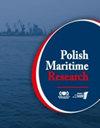Effects of Propeller Fouling on the Hydrodynamic Performance of a Marine Propeller
IF 2
3区 工程技术
Q2 ENGINEERING, MARINE
引用次数: 0
Abstract
Abstract Propeller performance is typically considered under clean conditions, despite the fact that fouling is an inevitable phenomenon for propellers. The main objective of this study is to investigate the effects of roughness due to fouling on the performance of a propeller using a CFD simulation in conjunction with the roughness function model. A simulation of a clean propeller is verified for a five-blade propeller model using existing experimental results. A roughness function model is then suggested based on existing measured roughness data. The simulations are extended for the same propeller under varying severities of roughness. Initially, it is concluded that KT and ηo gradually decrease with increasing fouling roughness, while KQ increases, compared to smooth propeller. For instance, at J=1.2 for medium calcareous fouling, KT is reduced by about 26%, KQ increases by about 7.0%, and ηo decreases by 30.9%. In addition, for the rough propeller, the extra power required is defined as the specific sea margin (SSM) to compensate for the power loss. A slight roughness causes a large decrease in ηo. A propeller painted with foul-release paint and an unpainted propeller are found to require 2.7% SSM and 57.8% SSM over four years of service, respectively. Finally, the use of foul-release paints for propeller painting is strongly advised.螺旋桨污垢对船用螺旋桨水动力性能的影响
摘要 尽管污垢是螺旋桨不可避免的现象,但螺旋桨的性能通常是在清洁条件下考虑的。本研究的主要目的是结合粗糙度函数模型,利用 CFD 仿真研究污垢造成的粗糙度对螺旋桨性能的影响。利用现有的实验结果,对五叶螺旋桨模型的清洁螺旋桨进行了模拟验证。然后根据现有的粗糙度测量数据提出了粗糙度函数模型。对同一螺旋桨在不同粗糙度条件下的模拟进行了扩展。初步结论是,与光滑螺旋桨相比,随着污垢粗糙度的增加,KT 和 ηo 逐渐减小,而 KQ 增加。例如,对于中等钙质污垢,当 J=1.2 时,KT 降低了约 26%,KQ 增加了约 7.0%,ηo 降低了 30.9%。此外,对于粗糙度较高的螺旋桨,所需的额外功率被定义为特定海缘(SSM),以补偿功率损失。轻微的粗糙度会导致 ηo 的大幅下降。涂有除污涂料的螺旋桨和未涂刷涂料的螺旋桨在四年的服役期内分别需要 2.7% 和 57.8% 的 SSM。最后,强烈建议在螺旋桨喷漆时使用除污漆。
本文章由计算机程序翻译,如有差异,请以英文原文为准。
求助全文
约1分钟内获得全文
求助全文
来源期刊

Polish Maritime Research
工程技术-工程:海洋
CiteScore
3.70
自引率
45.00%
发文量
20
审稿时长
>12 weeks
期刊介绍:
The scope of the journal covers selected issues related to all phases of product lifecycle and corresponding technologies for offshore floating and fixed structures and their components.
All researchers are invited to submit their original papers for peer review and publications related to methods of the design; production and manufacturing; maintenance and operational processes of such technical items as:
all types of vessels and their equipment,
fixed and floating offshore units and their components,
autonomous underwater vehicle (AUV) and remotely operated vehicle (ROV).
We welcome submissions from these fields in the following technical topics:
ship hydrodynamics: buoyancy and stability; ship resistance and propulsion, etc.,
structural integrity of ship and offshore unit structures: materials; welding; fatigue and fracture, etc.,
marine equipment: ship and offshore unit power plants: overboarding equipment; etc.
 求助内容:
求助内容: 应助结果提醒方式:
应助结果提醒方式:


